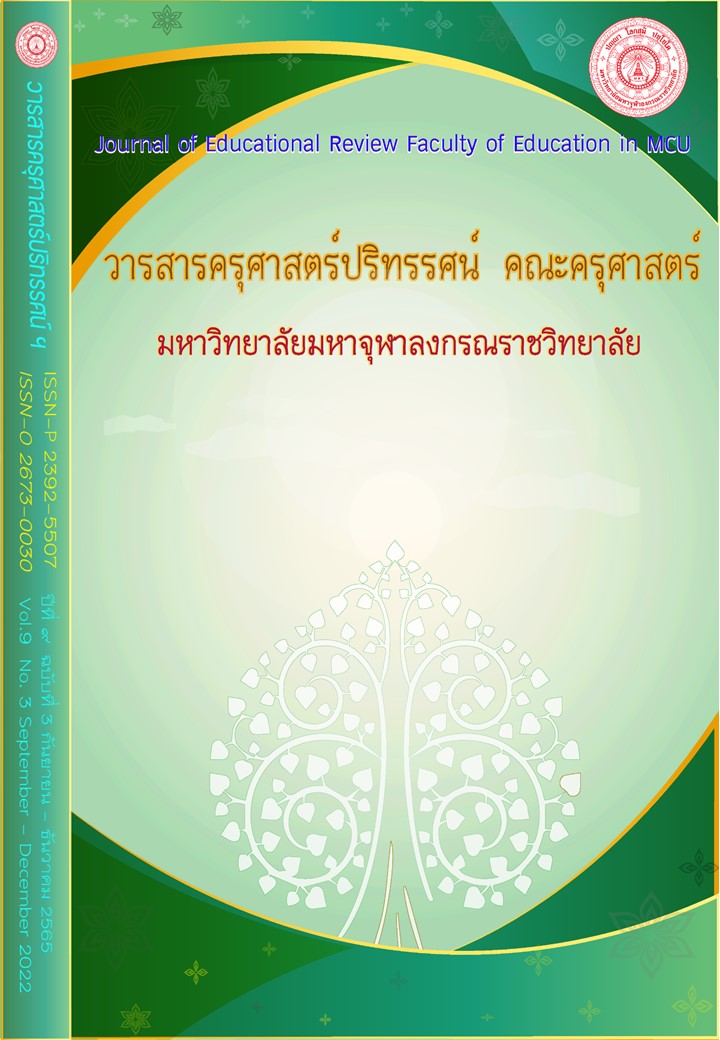SYNERGISTIC LEADERSHIP AND RELATIONSHIP WITH THE COMMUNITY Of SCHOOL DIRECTORS UNDER THE SAMUT PRAKAN SECONDARY EDUCATION SERVICE AREA OFFICE
Main Article Content
Abstract
This research article aims to 1) study the level of synergistic leadership of the school administrators; 2) study the level of relationship-building with the community of the school administrators, and 3) study the relationship between the synergistic leadership and the relationship-building with the community of the school administrators under the Secondary Educational Service Area Office Samut Prakan. This research is a quantitative research. The sample group consisted of 221 teachers at schools under the Secondary Educational Service Area Office Samut Prakan. Research instrument was 5 rating scale with IOC between 0.67 - 1.00 and the reliability at 0.98. The data were analyzed using Frequency, Percentage, Mean, Standard Deviation, and Pearson Product Moment Correlation. Findings revealed that 1) the synergistic leadership of the school administrators under the Secondary Educational Service Area Office Samut Prakan overall was found in a high level; 2) the relationship-building with the community of the school administrators under the Secondary Educational Service Area Office Samut Prakan overall was found in a high level, and 3) the synergistic leadership and the relationship-building with the community of the school administrators under the Secondary Educational Service Area Office Samut Prakan showed positive relationship at a statistically significant level of .01 in the highest level.
Article Details

This work is licensed under a Creative Commons Attribution-NonCommercial-NoDerivatives 4.0 International License.
ทัศนะและความคิดเห็นที่ปรากฏในบทความในวารสารฉบับนี้ถือเป็นความรับผิดชอบของผู้เขียนบทความนั้นเพียงผู้เดียว และไม่ถือเป็นทัศนะและความรับผิดชอบของกองบรรณาธิการ
กองบรรณาธิการขอสงวนสิทธิ์ในการคัดเลือกบทความลงตีพิมพ์และจะแจ้งให้เจ้าของบทความทราบหลังจากผู้ประเมินบทความตรวจอ่านบทความแล้ว
ต้นฉบับที่ได้รับการตีพิมพ์ในวารสารครุศาสตร์ปริทรรศน์ คณะครุศาสตร์ มหาวิทยาลัยมหาจุฬาลงกรณราชวิทยาลัย ถือเป็นกรรมสิทธิ์ของคณะครุศาสตร์ มหาวิทยาลัยมหาจุฬาลงกรณราชวิทยาลัย ห้ามนำข้อความทั้งหมดหรือบางส่วนไปพิมพ์ซ้ำ เว้นเสียแต่ว่าจะได้รับอนุญาตจากมหาวิทยาลัยฯ เป็นลายลักษณ์อักษร
References
กระทรวงศึกษาธิการ. (2553). พระราชบัญญัติการศึกษาแห่งชาติ พ.ศ. 2542 แก้ไขเพิ่มเติม (ฉบับที่ 2) พ.ศ. 2545 และ(ฉบับที่ 3) พ.ศ. 2553. กรุงเทพมหานคร: กระทรวงศึกษาธิการ.
กระทรวงศึกษาธิการ. (2559). การปฏิรูปครู: ขับเคลื่อนการปฏิรูปการศึกษาของประเทศ. แหล่งที่มา https://sites.google.com/a/birdkm.com/birdkm/education/education-reform-2016 สืบค้นเมื่อ 6 มี.ค. 2561.
กระทรวงศึกษาธิการ. (2561). ประกาศกระทรวงศึกษาธิการ เรื่องมาตรฐานการอุดมศึกษา พ.ศ. 2561. แหล่งที่มา www.mua.go.th/user/he-commiddion/doc/12%20standard%20U.pdf. สืบค้นเมื่อ 17 ส.ค. 2561.
กฤตยา มงคลวงษ์. (2560). การพัฒนารูปแบบการบริหารความสัมพันธ์ระหว่างโรงเรียนกับชุมชนของโรงเรียน (ภาครัฐ) ในสังกัดสำนักงานเขตพื้นที่การศึกษาประถมศึกษาชลบุรี เขต 3. ดุษฎีนิพนธ์ปรัชญาดุษฎีบัณฑิต. มหาวิทยาลัยบูรพา.
ชุติมา พรหมผุย. (2562). คุณลักษณะภาวะผู้นำแบบประสานพลังของนักศึกษาหลักสูตรประกาศนียบัตรวิชาชีพครู คณะศึกษาศาสตร์และศิลปะศาสตร์ วิทยาลัยนครราชสีมา. วารสารวิทยาลัยนครราชสีมา. 13(3). 88-101.
ธีวรัตน์ ไชยสิทธิ์. (2560). การสร้างความสัมพันธ์ระหว่างโรงเรียนกับชุมชนของโรงเรียนพระแสงวิทยา สังกัดสำนักงานเขตพื้นที่การศึกษามัธยมศึกษา เขต 11. วิทยานิพนธ์การศึกษามหาบัณฑิต. มหาวิทยาลัยบูรพา.
ประคัลภ์ ปัณฑพลังกูร. (2556). 7 Habits: อุปนิสัยที่ 6 Synergize. แหล่งที่มา http://prakal.wordpress.com/2012/07/30/7-habits. สืบค้นเมื่อ 17 ส.ค. 2561.
พระมหาอุดร อุตฺตโร. (2561). ภาวะผู้นำ: การบริหารวิชาการสู่การศึกษายุค 4.0. วารสารปัญญาปณิธาน. 3(1). 42-53.
ยศกร เรืองไพศาล. (2562). ภาวะผู้นำดิจิทัลของผู้อำนวยการโรงเรียนที่ส่งผลต่อการสร้างความสัมพันธ์ระหว่างโรงเรียนกับชุมชนของโรงเรียนกลุ่ม 5 สังกัดสำนักงานเขตพื้นที่การศึกษามัธยมศึกษาเขต 1. วิทยานิพนธ์ศึกษาศาสตรมหาบัณฑิต. มหาวิทยาลัยเกษตรศาสตร์.
รุ่งทิพย์ เข็มทิศ. (2559). การสร้างความสัมพันธ์ระหว่างโรงเรียนกับชุมชนของโรงเรียนเทศบาลแหลมฉบัง 3 อำเภอศรีราชา จังหวัดชลบุรี. วิทยานิพนธ์การศึกษามหาบัณฑิต. มหาวิทยาลัยบูรพา.
ฤทัย วรรธนวินิจ. (2561). แนวทางในการพัฒนารูปแบบการบริหารจัดการระบบสุขภาพโดยคณะกรรมการพัฒนาคุณภาพชีวิตและระบบสุขภาพอำเภอ ศึกษาเฉพาะกรณีอำเภอเมือง จังหวัดสมุทรปราการ. สมุทรปราการ: โรงพยาบาลสมุทรปราการ.
วาสนา ชูแสง. (2557). การดำเนินงานการสร้างความสัมพันธ์ระหว่างโรงเรียนกับชุมชนของโรงเรียนสังกัดสำนักงานเขตราษฎร์บูรณะ กรุงเทพมหานคร. วิทยานิพนธ์ครุศาสตรมหาบัณฑิต. มหาวิทยาลัยราชภัฏธนบุรี.
วิจารณ์ พานิช. (2558). เรียนรู้สู่การเปลี่ยนแปลง. กรุงเทพมหานคร: เอส.อาร์.พริ้นติ้ง.
สำนักรับรองมาตรฐานและประเมินคุณภาพการศึกษา. (2556). คุณภาพศิษย์สะท้อนคุณภาพครู. กรุงเทพมหานคร: แม็ทซ์พอยท์.
Bryant, S.E. (2003). The role of transformational and transactional leadership in creating, sharing and exploiting organizational knowledge. Journal of Leadership and Organizational Studies. 9(4). 1-13.
Good, C. V. (1973). Dictionary of education. 3rd ed. New York: McGraw-Hill.
Haris, A. (2004). Distributed Leadership and School Improvement: Leading or Misleading. From https://journals.sagepub.com/doi/10.1177/1741143204039297. Retrieved May 6, 2020.
Karakus, M. & Toremen, F. (2008). How our schools can be more synergic: Determining the obstacles of teamwork. Team Performance Management. 14(6). 233-247.
Krejcie, R. V. & Morgan, D. W. (1970). Determining sample size for research activities. Educational and Psychological Measurement. 30(3). 607-610.
Lawrence, K. (2013). Developing Leaders in a VUCA Environment. From http://www.cfmt.it/pdf/articoli/developing-leaders-in-a-vuca-environment.pdf. Retrieved October 19, 2020.
Mumford, M.D. (2009). What is the fundamental? The role of cognition in creativity and innovation. Industrial and Organizational Psychology. 2. 353-356.


